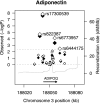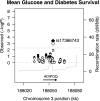Common variants in the adiponectin gene (ADIPOQ) associated with plasma adiponectin levels, type 2 diabetes, and diabetes-related quantitative traits: the Framingham Offspring Study
- PMID: 18776141
- PMCID: PMC2584143
- DOI: 10.2337/db08-0700
Common variants in the adiponectin gene (ADIPOQ) associated with plasma adiponectin levels, type 2 diabetes, and diabetes-related quantitative traits: the Framingham Offspring Study
Abstract
Objective: Variants in ADIPOQ have been inconsistently associated with adiponectin levels or diabetes. Using comprehensive linkage disequilibrium mapping, we genotyped single nucleotide polymorphisms (SNPs) in ADIPOQ to evaluate the association of common variants with adiponectin levels and risk of diabetes.
Research design and methods: Participants in the Framingham Offspring Study (n = 2,543, 53% women) were measured for glycemic phenotypes and incident diabetes over 28 years of follow-up; adiponectin levels were quantified at exam 7. We genotyped 22 tag SNPs that captured common (minor allele frequency >0.05) variation at r(2) > 0.8 across ADIPOQ plus 20 kb 5' and 10 kb 3' of the gene. We used linear mixed effects models to test additive associations of each SNP with adiponectin levels and glycemic phenotypes. Hazard ratios (HRs) for incident diabetes were estimated using an adjusted Cox proportional hazards model.
Results: Two promoter SNPs in strong linkage disequilibrium with each other (r(2) = 0.80) were associated with adiponectin levels (rs17300539; P(nominal) [P(n)] = 2.6 x 10(-8); P(empiric) [P(e)] = 0.0005 and rs822387; P(n) = 3.8 x 10(-5); P(e) = 0.001). A 3'-untranslated region (3'UTR) SNP (rs6773957) was associated with adiponectin levels (P(n) = 4.4 x 10(-4); P(e) = 0.005). A nonsynonymous coding SNP (rs17366743, Y111H) was confirmed to be associated with diabetes incidence (HR 1.94 [95% CI 1.16-3.25] for the minor C allele; P(n) = 0.01) and with higher mean fasting glucose over 28 years of follow-up (P(n) = 0.0004; P(e) = 0.004). No other significant associations were found with other adiposity and metabolic phenotypes.
Conclusions: Adiponectin levels are associated with SNPs in two different regulatory regions (5' promoter and 3'UTR), whereas diabetes incidence and time-averaged fasting glucose are associated with a missense SNP of ADIPOQ.
Figures


References
-
- Scherer PE: Adipose tissue: from lipid storage compartment to endocrine organ. Diabetes 55 :1537 –1545,2006 - PubMed
-
- Mori Y, Otabe S, Dina C, Yasuda K, Populaire C, Lecoeur C, Vatin V, Durand E, Hara K, Okada T, Tobe K, Boutin P, Kadowaki T, Froguel P: Genome-wide search for type 2 diabetes in Japanese affected sib-pairs confirms susceptibility genes on 3q, 15q, and 20q and identifies two new candidate loci on 7p and 11p. Diabetes 51 :1247 –1255,2002 - PubMed
-
- Vionnet N, Hani EH, Dupont S, Gallina S, Francke S, Dotte S, De Matos F, Durand E, Lepretre F, Lecoeur C, Gallina P, Zekiri L, Dina C, Froguel P, Hani EH: Genomewide search for type 2 diabetes-susceptibility genes in French whites: evidence for a novel susceptibility locus for early-onset diabetes on chromosome 3q27-qter and independent replication of a type 2-diabetes locus on chromosome 1q21–q24. Am J Hum Genet 67 :1470 –1480,2000 - PMC - PubMed
-
- Menzaghi C, Trischitta V, Doria A: Genetic influences of adiponectin on insulin resistance, type 2 diabetes, and cardiovascular disease. Diabetes 56 :1198 –1209,2007 - PubMed
-
- Kannel WB, Feinleib M, McNamara PM, Garrison RJ, Castelli WP: An investigation of coronary heart disease in families: the Framingham Offspring Study. Am J Epidemiol 110 :281 –290,1979 - PubMed
Publication types
MeSH terms
Substances
Grants and funding
LinkOut - more resources
Full Text Sources
Medical
Miscellaneous

